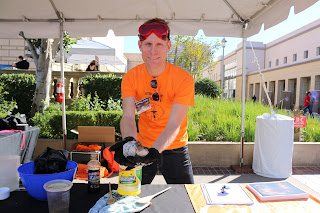 |
| All photographs were taken by Christophe Marcade. |
Today was the Pasadena Astronomy Festival, the final event of Pasadena Astronomy Week at the Pasadena Convention Center. It was a whole-day event staffed by members of all of the Pasadena-based astronomy institutions: Caltech, JPL, IPAC, Carnegie, Planetary Society, Mt. Wilson Observatory, Thirty Meter Telescope, Giant Magellan Telescope, and KidSpace.
There were all sorts of activities and booths set up for members of the public to visit and learn about the universe. There was the booth demonstrating how to make a comet with household materials (and dry ice):
The all-terrain Mars Rover that could ride over bumpy surfaces like children:
A couple of infrared cameras demonstrating how things look in the near-infrared part of the spectrum (primarily by surface temperature):
And our telescopes set up to observe the sun during the day, and astronomical targets at night:
--Cameron




























